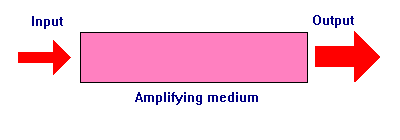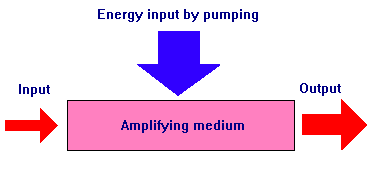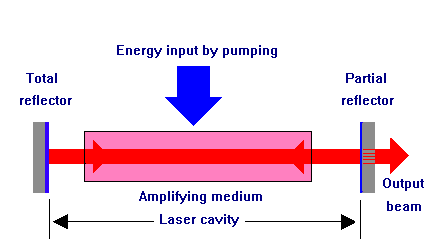1 Amplification of light
All lasers contain an energized substance that can increase the intensity of light passing through it. This substance is called the amplifying medium and it can be a solid, a liquid or a gas. An exceptional case is the Free Electron Laser (FEL), in which the amplifying medium is not a substance in the normal sense, but is a beam of electrons that move rapidly along an undulating path in vacuum. In this tutorial, we will be concerned with more conventional lasers. How the amplifying medium increases the intensity of light passing through it will be explained in sections 4 and 5. For the moment, we will just assume that light amplification is possible. In a neodymium YAG (Nd:YAG) laser, the amplifying medium is a rod of yttrium aluminium garnate (YAG) containing neodymium ions. In a dye laser, it is a solution of a fluorescent dye in a solvent such as methanol. In a helium-neon laser, it is a mixture of the gases helium and neon. In a laser diode, it is a thin layer of semiconductor material sandwiched between other semiconductor layers. The factor by which the intensity of the light is increased by the amplifying medium is known as the gain. The gain is not a constant for a particular type of medium. It depends critically upon the wavelength of the incoming light, the length of the amplifying medium and also upon the extent to which the amplifying medium has been energized.
2 Energizing the amplifying mediumIncreasing the intensity of a light beam that passes through an amplifying medium amounts to putting additional energy into the beam. This energy comes from the amplifying medium which must in turn have energy fed into it in some way. In laser terminology, the process of energizing the amplifying medium is known as "pumping".
There are several ways of pumping an amplifying medium. When the amplifying medium is a solid, pumping is usually achieved by irradiating it with intense light. This light is absorbed by atoms or ions within the medium and raises them into higher energy states. Often, the pumping light comes from xenon-filled flashtubes that are positioned alongside the amplifying medium. Passing a high voltage electric discharge through the flashtubes causes them to emit an intense flash of white light, some of which is absorbed by the amplifying medium. A laser that is pumped in this way will have a pulsed output.
Pumping an amplifying medium by irradiating it with intense light is usually referred to optical pumping. In some cases, the source of the pumping light is another laser. Gaseous amplifying media have to be contained in some form of enclosure or tube and are often pumped by passing an electric discharge through the medium itself. The mechanism by which this elevates atoms or molecules in the gas to higher energy states depends upon the gas that is being excited and is often complex. In many gas lasers, the end windows of the laser tube are inclined at an angle and they are referred to as brewster windows. Brewster windows are able to transmit a beam that is polarized in the plane of the diagram without losses due to reflection. Such a laser would have an output beam that is polarized.
The diagram illustrates pumping by passing a discharge longitudinally through the gaseous amplifying medium but, in some cases, the discharge takes place transversely from one side of the medium to the other. Many lasers that are pumped by an electric discharge can produce either a pulsed output or a continuous output depending upon whether the discharge is pulsed or continuous. Various other methods of pumping the amplifying medium in a laser are used. For example, laser diodes are pumped by passing an electric current across the junction where the two types of semiconductor within the diode come together. 3 Laser oscillatorPumped amplifying media as described in section 2 could be used to increase the intensity of light at particular wavelengths and such arrangements are often incorporated into laser systems. However, except in a few exceptional cases, light amplifiers would not be regarded as lasers. A laser consists of a pumped amplifying medium positioned between two mirrors as indicated below. The purpose of the mirrors is to provide what is described as 'positive feedback'. This means simply that some of the light that emerges from the amplifying medium is reflected back into it for further amplification. The arrangement of an amplifier with provision for positive feedback is known as an oscillator.
The space between the two mirrors is known as the laser cavity. The beam within the cavity undergoes multiple reflections between the mirrors and is amplified each time it passes through the amplifying medium. One of the mirrors reflects almost all of the light that falls upon it (total reflector in the above diagram). The other mirror reflects between 20% and 98% of the incident light depending upon the type of laser, the light that is not reflected being transmitted through the mirror. The transmitted portion constitutes the output beam of the laser. The laser cavity has several important functions. Following pumping, spontaneous emission of light from excited atoms within the amplifying medium initiates the emission of low intensity light into the laser cavity. This light is increased in intensity by multiple passes through the amplifying medium so that it rapidly builds up into an intense beam. In the absence of cavity mirrors, this self-starting process, or oscillation, would not occur. The cavity helps to ensure that the divergence of the beam is small. Only light that travels in a direction closely parallel to the axis of the cavity can undergo multiple reflections at the mirrors and make multiple passes through the amplifying medium. More divergent rays will execute a zig-zag path within the cavity and wander out of it. The laser cavity also improves the spectral purity of the laser beam. Usually, the amplifying medium will amplify light within a narrow range of wavelengths. However, within this narrow range, only light of particular wavelengths can undergo repeated reflection up and down the cavity. The characteristics that a light beam within the cavity must possess in order to undergo repeated reflections define what is referred to as a cavity mode. Light which may still be amplified by the amplifying medium but which does not belong to one of these special modes of oscillation is rapidly attenuated and will not be present in the output beam. This behaviour is similar to that of a vibrating guitar string in that a particular string will only vibrate at certain frequencies. In a similar way, an optical cavity will only sustain repeated reflections for particular well-defined wavelengths of light. 4 Absorption and emission of light by atomsSo far, nothing has been written about how an amplifying medium amplifies light. This will be dealt with here and in the next section. We must begin with an account of how light can interact with individual atoms within an amplifying medium ("atoms" will be used to include molecules and ions). Atoms consist of a positively charged core (nucleus) which is surrounded by negatively charged electrons. According to the quantum mechanical description of an atom, the energy of an atomic electron can have only certain values and these are represented by energy levels. The electrons can be thought of as orbiting the nucleus, those with the largest energy orbiting at greater distances from the nuclear core. There are many energy levels that an electron within an atom can occupy, but here we will consider only two. Also, we will consider only the electrons in the outer orbits of the atom as these can most easily be raised to higher unfilled energy states. Absorption and Spontaneous Emission The processes of the absorption and spontaneous emission of light are illustrated below:
A photon of light is absorbed by an atom in which one of the outer electrons is initially in a low energy state denoted by 0. The energy of the atom is raised to the upper energy level, 1, and remains in this excited state for a period of time that is typically less than 10-6 second. It then spontaneously returns to the lower state, 0, with the emission of a photon of light. Absorption is referred to as a resonant process because the energy of the absorbed photon must be equal to the difference in energy between the levels 0 and 1. This means that only photons of a particular frequency (or wavelength) will be absorbed. Similarly, the photon emitted will have energy equal to the difference in energy between the two energy levels. These common processes of absorption and spontaneous emission cannot give rise to the amplification of light. The best that can be achieved is that for every photon absorbed, another is emitted. Stimulated Emission Stimulated emission is a very uncommon process in nature but it is central to the operation of lasers.
Above it was stated that an atom in a high energy, or excited, state can return to the lower state spontaneously. However, if a photon of light interacts with the excited atom, it can stimulate a return to the lower state. One photon interacting with an excited atom results in two photons being emitted. Furthermore, the two emitted photons are said to be in phase, i.e. thinking of them as waves, the crest of the wave associated with one photon occurs at the same time as on the wave associated with the other. This is the process that can give rise to the amplification of light. As with absorption, it is a resonant process - the energy of the incoming photon of light must match the difference in energy between the two energy levels. Furthermore, if we consider a photon of light interacting with a single atom, stimulated emission is just as likely as absorption; which process occurs depends upon whether the atom is initially in the lower or the upper energy level. However, under most conditions, stimulated emission does not occur to a significant extent. The reason is that, under most conditions, there will be far more atoms in the lower energy level, 0, than in the upper level, 1, so that absorption will be much more common than stimulated emission. If stimulated emission is to predominate, we must have more atoms in the higher energy state than in the lower one. This unusual condition is referred to as a population inversion and it is necessary to create a population inversion for laser action to occur. 5 Creating a Population InversionFinding substances in which a population inversion can be set up is central to the develpment of new kinds of laser. The first material used was synthetic ruby. Ruby is crystalline alumina (Al2O3) in which a small fraction of the Al3+ ions have been replaced by chromium ions, Cr3+. It is the chromium ions that give rise to the characteristic pink or red color of ruby and it is in these ions that a population inversion is set up in a ruby laser.
In a ruby laser, a rod of ruby is irradiated with the intense flash of light from xenon-filled flashtubes. Light in the green and blue regions of the spectrum is absorbed by chromium ions, raising the energy of electrons of the ions from the ground state level to the broad F bands of levels. Electrons in the F bands rapidly undergo non-radiative transitions to the two metastable E levels. A non-radiative transition does not result in the emission of light; the energy released in the transition is dissipated as heat in the ruby crystal. The metastable levels are unusual in that they have a relatively long lifetime of about 4 milliseconds (4 x 10-3 s), the major decay process being a transition from the lower level to the ground state. This long lifetime allows a high proportion (more than a half) of the chromium ions to build up in the metastable levels so that a population inversion is set up between these levels and the ground state level. This population inversion is the condition required for stimulated emission to overcome absorption and so give rise to the amplification of light. In an assembly of chromium ions in which a population inversion has been set up, some will decay spontaneously to the ground state level emitting red light of wavelength 694.3 nm in the process. This light can then interact with other chromium ions that are in the metastable levels causing them to emit light of the same wavelength by stimulated emission. As each stimulating photon leads to the emission of two photons, the intensity of the light emitted will build up quickly. This cascade process in which photons emitted from excited chromium ions cause stimulated emission from other excited ions is indicated below:
The ruby laser is often referred to as an example of a three-level system. More than three energy levels are actually involved but they can be put into three categories.These are; the lower level form which pumping takes place, the F levels into which the chromium ions are pumped, and the metastable levels from which stimulated emission occurs. Other types of laser operate on a four level system and , in general, the mechanism of amplification differs for different lasing materials. However, in all cases, it is necessary to set up a population inversion so that stimulated emission occurs more often than absorption. |








